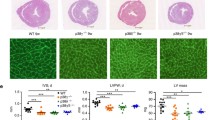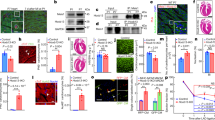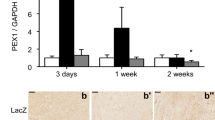Abstract
S100A1 and S100B are members of a family of 20 kDa Ca2++-binding homodimers that play a role in signal transduction in mammalian cells. S100A1 is the major isoform in normal heart and S100B, normally a brain protein, is induced in hypertrophic myocardium and functions as an intrinsic negative modulator of the hypertrophic response. In order to examine the function of S100A1, we first showed that, in contrast to S100B, S100A1 was downregulated in rat experimental models of myocardial hypertrophy following myocardial infarction or pressure overload. Second, in co-transfection experiments in cultured neonatal rat cardiac myocytes, S100A1 inhibited the α1-adrenergic activation of promoters of genes induced during the hypertrophic response including the fetal genes skeletal α actin (skACT), and β-myosin heavy chain (MHC) and S100B, but not the triiodothyronine (T3) activation of the promoter of the α-MHC gene, that is normally expressed in adult myocardium. These results suggest that S100A1 is involved in the maintenance of the genetic program that defines normal myocardial function and that its downregulation is permissive for the induction of genes that underlie myocardial hypertrophy.
Similar content being viewed by others
References
Schwartz K, Boheler KR, de la Bastie D, Lompre AM, Mercadier JJ: Switches in cardiac muscle gene expression as a result of pressure or volume overload. Am J Physiol. 262: R364-R369, 1992
Gidh-Jain M, Huang B, Jain P, Gick G, El-Sherif N: Alterations in cardiac gene expression during ventricular remodeling following experimental myocardial infarction. J Mol Cell Cardiol 30: 627-637, 1998
Chien KR, Zhu H, Knowlton KU, Miller-Hance W, van Bilsen M, O'Brien TX, Evans S: Transcriptional regulation during cardiac growth and development. Annu Rev Physiol 55: 77-95, 1993
Parker TG, Schneider MD: Growth factors, proto-oncogenes, and plasticity of the cardiac phenotype. Ann Rev Physiol 53: 179-200, 1991
Parker TG: Molecular biology of cardiac growth and hypertrophy. Hertz 18: 245-255, 1993
Bishopric NH, Simpson PC, Ordahl CP: Induction of the skeletal α-actin gene in α1-adrenoceptor-mediated hypertrophy of rat cardiac myocytes. J Clin Invest 80: 1194-1199, 1987
Waspe LE, Ordahl CP, Simpson PC: The cardiac β-myosin heavy chain isogene is induced selectively in α1-adrenergic receptor-stimulated hypertrophy of cultured rat heart myocytes. J Clin Invest 85: 1206-1214, 1990
Kariya K, Karns LR, Simpson PC: Expression of a constitutively activated mutant of the β-isozyme of protein kinase C in cardiac myocytes stimulates the promoter of the β-myosin heavy chain isogene. J Biol Chem 266: 10023-10026, 1991
Karns LR, Kariya K, Simpson PC: M-CAT, CArG, and Sp1 elements are required for α1-adrenergic induction of the skeletal α-actin promoter during cardiac myocyte hypertrophy. Transcriptional enhancer factor-1 and protein kinase C as conserved transducers of the fetal program in cardiac growth. J Biol Chem 270: 410-417, 1995
Kariya K, Farrance IKG, Simpson PC: Transcription enhancer factor-1 in cardiac myocytes interacts with an α1-adrenergic-and protein kinase C-inducible element in the rat β-myosin heavy chain promoter. J Biol Chem 268: 26658-26662, 1993
Kariya K, Karns LR, Simpson PC: An enhancer core element mediates stimulation of the rat β-myosin heavy chain promoter by an α1-adrenergic agonist and activated β-protein kinase C in hypertrophy of cardiac myocytes. J Biol Chem 269: 3775-3782, 1994
Donato R: S100: A multigene family of calcium-modulated proteins of the EF-hand type with intracellular and extracellular functional roles. Intern J Biochem Cell Biol. 3: 637-668, 2001
Tsoporis JN, Marks A, Kahn HJ, Butany JW, Liu PP, O'Hanlon D, Parker TG: S100β inhibits α1-adrenergic induction of the hypertrophic phenotype in cardiac myocytes. J Biol Chem 272: 31915-31921, 1997
Tsoporis JN, Marks A, Kahn HJ, Butany JW, Liu PP, O'Hanlon D, Parker TG: Inhibition of norepinephrine-induced cardiac hypertrophy in S100β transgenic mice. J Clin Invest 102: 1609-1616, 1998
Castets F, Griffin W ST, Marks A, Van Eldik LJ: Transcriptional regulation of the human S100B gene. Mol Brain Res 46: 208-216, 1997
Allore RJ, Friend WC, O'Hanlon D, Neilson KM, Baumal R, Dunn RJ, Marks A: Cloning and expression of the human S100B gene. J Biol Chem 265: 15537-15543, 1990
Landar A, Rustandi RR, Weber DJ, Zimmer DB: S100A1 utilizes different mechanisms for interacting with calcium-dependent and calcium-independent proteins. Biochem 37: 17429-17438, 1998
Yamauchi-Takihara K, Sole MJ, Liew J, Ing D, Liew CC: Characterization of the human cardiac myosin heavy chain genes. Proc Natl Acad Sci USA 86: 3504-3508, 1989
Orenstein TL, Parker TG, Butany JW, Goodman JM, Dawood F, Wen W-H, Wee L, Martino T, McLaughlin PR, Liu PP: Favorable left ventricular remodeling following large myocardial infarction by exercise training. Effect on left ventricular morphology and gene expression. J Clin Invest 96: 858-866, 1995
Anderson PG, Allard MF, Thomas GD, Bishop SP, Digerness SB: Increased ischemic injury but decreased hypoxic injury in hypertrophied rat hearts. Circ Res 67: 948-959, 1990
Simpson PC: Stimulation of hypertrophy of cultured neonatal rat heart cells through an α1-adrenergic receptor and induction of beating through an α1-and β1-adrenergic receptor interaction. Circ Res 56: 884-894, 1985
De Wet JR, Wood KV, De Luca M, Helinski DR, Subramani S: Firefly luciferase gene: Structure and expression in mammalian cells. Mol Cell Biol 7: 725-737, 1987
Gorman CM, Moffat LF, Howard BH: Recombinant genomes which express chloramphenicol acetyltransferase in mammalian cells. Mol Cell Biol 2: 1044-1051, 1982
Chomczynski P, Sacchi N: Single-step method of RNA isolation by acid guanidium thiocyanate-phenol-chloroform extraction. Anal Biochem 162: 156-159, 1987
Ilg EC, Schafer BW, Heizmann CW: Expression pattern of S100 calcium-binding proteins in human tumors. Int J Cancer 68: 325-332, 1996
Stewart AFR, Suzow J, Kubota T, Ueyama T, Hsiao-Huei C: Transcription factor RTEF-1 mediates α1-adrenergic reactivation of the fetal gene program in cardiac myocytes. Circ Res 83: 43-49, 1998
Yang Q, O'Hanlon D, Heizman CW, Marks A: Demonstration of heterodimer formation between S100B and S100A6 in the yeast two-hybrid system and human melanoma. Exp Cell Res 246: 501-509, 1999
Kiewitz R, Acklin C, Minder E, Huber PR, Schafer BW, Heizmann CW: S100A1, a new marker for acute myocardial ischemia. Biochem Biophys Res Commun 274: 865-871, 2000
Remppis A, Greten T, Schafer BW, Hunziker P, Erne P, Katus HA, Heizman CW: Altered expression of the Ca2+-binding protein S100A1 in human cardiomyopathy. Biochim Biophys Acta. 1313: 253-257, 1996
Author information
Authors and Affiliations
Rights and permissions
About this article
Cite this article
Tsoporis, J.N., Marks, A., Zimmer, D.B. et al. The myocardial protein S100A1 plays a role in the maintenance of normal gene expression in the adult heart. Mol Cell Biochem 242, 27–33 (2003). https://doi.org/10.1023/A:1021148503861
Issue Date:
DOI: https://doi.org/10.1023/A:1021148503861




